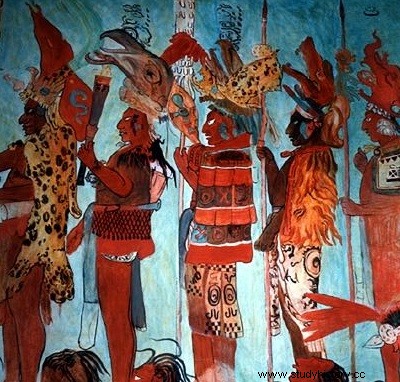 The Mayans are at the origin of a brilliant pre-Columbian civilization of Central America which had its apogee in the classical period between 200 and 900 AD. Their territories stretched from the Yucatán Peninsula to central Mexico. The main cities of this period were Tikal, Uaxactún, Piedras Negras and Quiriguá, in Guatemala; Copán, in Honduras; Palenque, Uxmal, Chichén Itzá and Yaxchilán, Mexico. Like the Aztecs, Mayan society was very hierarchical and practiced human sacrifices . The Mayan civilization, which one might think extinct since the Spanish invasion and disease, nevertheless survives through the current descendants, who have preserved ancestral traditions and are in search of recognition.
The Mayans are at the origin of a brilliant pre-Columbian civilization of Central America which had its apogee in the classical period between 200 and 900 AD. Their territories stretched from the Yucatán Peninsula to central Mexico. The main cities of this period were Tikal, Uaxactún, Piedras Negras and Quiriguá, in Guatemala; Copán, in Honduras; Palenque, Uxmal, Chichén Itzá and Yaxchilán, Mexico. Like the Aztecs, Mayan society was very hierarchical and practiced human sacrifices . The Mayan civilization, which one might think extinct since the Spanish invasion and disease, nevertheless survives through the current descendants, who have preserved ancestral traditions and are in search of recognition.
The Mayans:distant and fragmented origins
The provenance attributed to the Maya is common to pre-Columbian civilizations. It would initially be a people from Asia, arrived on the American continent during the Bering Strait glaciation. You should know that the Mayan civilization was unequal depending on the period, because the different regions have not developed at the same rate.
Historically, the Mayans of the Yucatán peninsula form the main people of this group to which they gave their name; the others, of lesser political importance, are the Huastecs of northern Veracruz, the Tzeltal, Tzotzil, Chols and Lacandons of Chiapas, the Quichés, Mams, Cakchiquels and Pokonchis of the highlands of Guatemala, and the Chortis from eastern Guatemala and western Honduras. With the exception of the Huastecs, isolated to the north, these peoples all occupy contiguous territories. They belong to the same culture which, in many respects, has reached a level of development that no other pre-Columbian civilization has equalled.
The Mayan civilization would be the result of the fusion between the indigenous peoples and tribes from Mexico or, more likely, the evolution of a single ethnic group.
The Mayan civilization
The Mesoamerican world and the Mayan world would revolve around several timelines. These begin in the Paleo-Indian period with nomadic hunter-gatherers (12,000 to 7000 BC), and end in the Postclassic period and the Spanish conquest (1000-1542 AD).
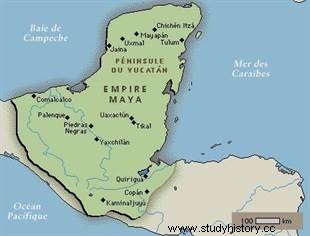 The Preclassic period (2000 to 400 BC) is a period of expansion and cohesion. It was from 2000 BC that small groups settled in Yucatan, excavations attest to the use of pottery. Human-shaped ceramics are made between 1000 and 300 BC. J.-C. — the most famous representations of this craft are the terracotta figurines of Jaina — then appears the bi- or polychrome ceramics. The first Mayan pyramids were built around 300 BC. AD
The Preclassic period (2000 to 400 BC) is a period of expansion and cohesion. It was from 2000 BC that small groups settled in Yucatan, excavations attest to the use of pottery. Human-shaped ceramics are made between 1000 and 300 BC. J.-C. — the most famous representations of this craft are the terracotta figurines of Jaina — then appears the bi- or polychrome ceramics. The first Mayan pyramids were built around 300 BC. AD
Climax of civilization takes place in the classic period from 200 to 900 AD. It characterizes an era of prosperous economy and cultural development thanks to the diffusion of writing, the calendar but also of polychrome ceramics. Large ceremonial centers like Palenque, Tikal and Copán are high at this time. During the ninth century, the Maya civilization “disappears”:the cities become depopulated, the cultural creations linked to public life and to the elites cease.
Extinction, migration, invasion, revolt? Traces of violence being rare, the researchers opt for a multi-causal thesis:economic dependence on other regions, the arrival of foreign populations, soil depletion, disruption of the ecological balance, would have created or accentuated the fracture between the ruling elite and the peasantry, in a context of competition between cities. At the end of the 8th century, the Maya territory extended over 324,000 km2 in Mesoamerica.
During the postclassic period, from 900 until the arrival of the Spaniards in the 16th century, the Mayan civilization was concentrated in Yucatán and was influenced by the Toltecs, a people originating from the Valley of Mexico. Chichen Itza, Tulum and Mayapan are major centers of this period. Wars and epidemics complete the disintegration of the Mayan civilization, and the Spaniards have no difficulty in subduing the remaining groups, although the Mexican government must wait until 1901 before conquering the last independent communities.
Mayan architecture and urban planning
Lost in the rainforest, the pre-Columbian Mayan cities were rediscovered in the 19th century. The Maya are remarkable architects, as evidenced by the imposing remains of a large number of sites, including Palenque, Uxmal, Mayapan, Copán, Tikal, Uaxactún, Chichén Itzá, Yaxchilán, Bonampak, Quiriguá, Kaminaljuyú and Cobá. Their cities are important ceremonial centers. Around large squares rise pyramids, observatory towers, palaces, commemorative stelae, altars, steam baths (utilitarian or ritual?) and "ball games" (outdoor constructions where two teams engage in dynastic or mythological, one of whose rules was to pass the ball in a circle). The Mayas also build roads connecting the cities to each other, bridges and underground aqueducts.
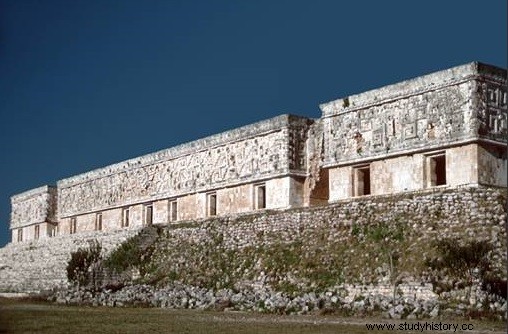 This civil and religious architecture, of which there are vestiges, is the transposition in stone of other buildings made of wood, adobe and thatch, their external aspects and their internal volumes. The pyramids result from the superposition of buildings built on a base to avoid flooding. Often surmounted by temples and grouped around squares, they have a facade of cut stone blocks and a fairly steep staircase on one or more sides. Stone walls are often laid without mortar. The wood is used for door lintels and for carving.
This civil and religious architecture, of which there are vestiges, is the transposition in stone of other buildings made of wood, adobe and thatch, their external aspects and their internal volumes. The pyramids result from the superposition of buildings built on a base to avoid flooding. Often surmounted by temples and grouped around squares, they have a facade of cut stone blocks and a fairly steep staircase on one or more sides. Stone walls are often laid without mortar. The wood is used for door lintels and for carving.
The Mayan cultural area is delimited in particular by the construction of false vaulted roofs:the layers of stone resting on the top of two parallel walls so as to meet at the top hold only thanks to the cement that unites them and not by a balance of forces. This system requires solid, and therefore thick, walls. As a result, the interior of the buildings is often not very spacious, the windows few, small and narrow. The interior and exterior facades are painted in bright colors. The exterior receives more sustained attention. The walls are luxuriously decorated with painted carvings, wooden ornaments, stucco moldings and mosaics. These decorations are usually assembled in broad friezes, contrasting with bands of simpler masonry.
The dwellings of the peasants, for their part, are noticeably similar to the adobe and thatch huts in which the descendants of the Maya live today.
The archaeological site of Tikal
In the lowland rainforests south of the Yucatán Peninsula, the ancient Maya built an important ceremonial center known as Tikal. Tikal, whose origins date back to 600 BC. J.-C., is a Maya city of major importance whose dominance covers the entire classical period of the Maya civilization (300-900 AD). An important commercial, religious and political center, Tikal was home to a population of 50,000 at its height during the Late Classic period (600-900 AD).
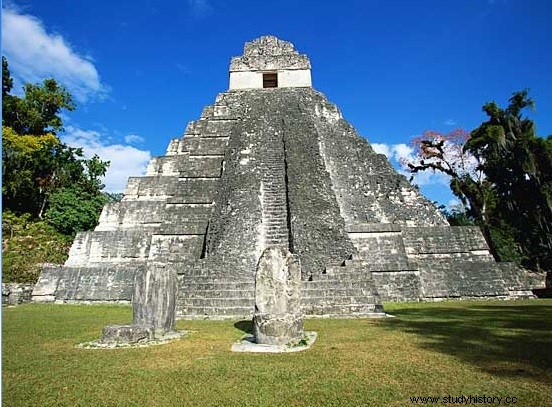 Tikal, like other Mayan cities, experienced a sudden and mysterious collapse around 900 AD. The reasons for this decline remain unknown, but specialists lean towards a problem of overpopulation, epidemics, war or even the depletion of resources. After the abandonment of the city of Tikal, the Maya continue to live in the surrounding lowlands as well as in the highlands further south.
Tikal, like other Mayan cities, experienced a sudden and mysterious collapse around 900 AD. The reasons for this decline remain unknown, but specialists lean towards a problem of overpopulation, epidemics, war or even the depletion of resources. After the abandonment of the city of Tikal, the Maya continue to live in the surrounding lowlands as well as in the highlands further south.
Millions of people still speak Mayan dialects in parts of Mexico and Central America today. The ruins of Tikal are now part of the Tikal National Park in the Petén region of northern Guatemala. The park itself is part of a larger reserve, the Maya Biosphere, which covers 575 km2 of the surrounding rainforest.
A hierarchical society
There are multiple social categories within each Mayan city:craftsmen, traders, warriors, priests, nobles, civil servants or even slaves. Rank is based on heredity, but military exploits favor social ascent . Any inhabitant can participate in the defense of the kingdom and fight. It was during the postclassic period that two elite military orders appeared:the eagle warriors and the jaguar warriors.
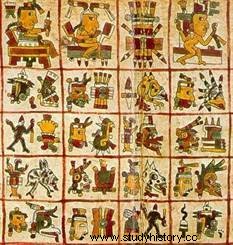 The majority of the population is made up of peasants who are of heterogeneous classes, there are poor and rich . Crafting is more of a noble activity because it requires full-time specialists, pampered by power. Indeed, the making of Codex , manuscript in bark paper including pictographs and texts in glyphs, requires the craftsman to have real know-how. This job requires knowledge of papermaking techniques and a good understanding of drawings. As for the inhabitants of the palaces, they are officials helping to collect the tribute.
The majority of the population is made up of peasants who are of heterogeneous classes, there are poor and rich . Crafting is more of a noble activity because it requires full-time specialists, pampered by power. Indeed, the making of Codex , manuscript in bark paper including pictographs and texts in glyphs, requires the craftsman to have real know-how. This job requires knowledge of papermaking techniques and a good understanding of drawings. As for the inhabitants of the palaces, they are officials helping to collect the tribute.
The burial discoveries clearly demonstrate the existence of a class society . Witness the bodies of the elites, external signs of prestige and wealth:cranial deformation, filed teeth and encrustation of small jade plates on the upper teeth. The discoveries have also made it possible to determine a fairly low life expectancy which oscillates between 35 and 40 years.
The economy of the Mayans
The economy is mainly based on agriculture and trade . The Mayas practiced slash and burn agriculture consisting of clearing a field and burning the vegetation as fertilizer, and terrace agriculture. They grew corn which is the basic resource, squash and beans but also peppers, avocados and tomatoes. Hunting and fishing were practiced to a lesser extent. Metallurgy and animal husbandry do not exist in the Mayan culture. Indeed, the Mayans did not use the wheel and the plow, because they did not have draft animals. They could carry up to 50 kilos of load themselves.
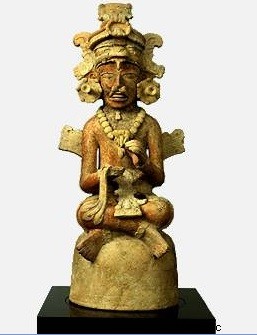 The Mayan peoples who did not live in autarky imported certain products over long distances such as salt, chocolate, textiles or hard stone:obsidian, a volcanic rock. Markets allowed merchants to present essential but also luxury foreign products such as jaguar skins, jade, quetzal feathers. The absence of money favored the use of barter and certain alternatives of "currencies":cocoa beans, feathers...
The Mayan peoples who did not live in autarky imported certain products over long distances such as salt, chocolate, textiles or hard stone:obsidian, a volcanic rock. Markets allowed merchants to present essential but also luxury foreign products such as jaguar skins, jade, quetzal feathers. The absence of money favored the use of barter and certain alternatives of "currencies":cocoa beans, feathers...
Religion and the maintenance of the cosmos
The mythical Maya world is populated by allegorical creatures symbolizing rain, celestial force, lightning or wind. The sculpted or painted images represent hybrid beings with monstrous figures. There are two types:creatures with short noses which have feline, solar attributes and those with elongated snouts associated with reptiles, with the earth. We notice the opposition of the two forces between diurnal and nocturnal creatures:the sun/the earth, life/death. There are no temples dedicated to the gods in the classical period, but pyramid temples erected to the glory of the sovereign.
The king is considered the high priest and the representative of supernatural forces. He is often decked out with a scepter and a ceremonial bar and is the guarantor of the balance of the Cosmos. It is for this reason that he must ensure the continuity of the universe by monitoring the smooth running of the sacrifices. Aided by priests, its main religious function involves the performance of several rites:sacrifice, self-sacrifice and incensing …
Sacrifices take many forms:beheading, ripping out the heart, or self-sacrifice which consists of drawing one's own blood by cutting one's ear, lobe, tongue or other members. These rituals have the same two phases:the actual execution and the offering. This amounts to presenting the image of the sacrificed person in a bowl via a ribbon of bloodstained paper. You should know that animals are also sacrificed:fish, snakes, birds and jaguars. Offerings are essential in Mayan culture. To accompany the deceased, the elites leave their family members with other categories of offerings:knives, jade objects, etc.
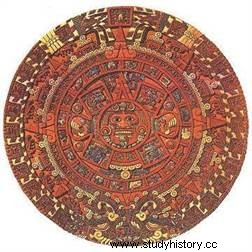
The rites are based on two annual calendars. The first the Haab determines the dates of ceremonies over 365 days and brings predictions to the people. The second, the Tzolkin acts as a religious almanac comprising 260 days and helps shamans name children after the day of their birth.
The Mayan calendar or rather the Mayan calendars
Let's start by talking about Mayan calendars, in the plural, because this civilization used several calendar systems. Indeed, the Mayas used the Tzolk'in a 260-day calendar used in the fields of religion and divination. They also used the Haab, a 365-day solar calendar. These calendars are common to all Mesoamerican civilizations. The Mayas also used a third calendar, called the long count, whose starting point would be August 11, 3114 BC. J-C.
This does not mean that this type of calendar is so old, it is only found from 31 BC. J-C on Stela C of Tres Zapotes (Mexico, state of Veracruz). The Long Count calendar was not actually used by the Maya until the Classic period, that is to say between 250 and 900 AD. J-C. It should be noted in passing that the concordance between the long count and our Julian calendar was made possible thanks to the transcription by the two cultures of events from the Spanish colonization in the 16th century.
This long count calendar is a vigesimal system (i.e. base twenty, not ten as in our current system):the base unit was the kin (one day), twenty kin formed a winal (a Mayan month) and 18 kin formed a tun, that is to say a year of 360 days. As we can see, there is a slight twist in the vigesimal system since a year is made up of 18 kin and not of 20. The long count also included two other higher units:the katun, made up of 20 tuns, and the baktun, composed of 20 katuns. This system was replaced around the 9th / 10th century by the short count, making it possible to locate a day more precisely over a shorter period.
The cycle of worlds
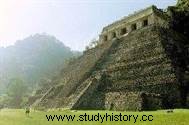 The Mayan cosmogony is only partially known to us thanks to sources that survived Spanish colonization. The most important document on this subject is the Popol Vuh, a book written by a Mayan ethnic group from Guatemala (the Quiché people) and transcribed between 1701 and 1703 by the priest Francisco Ximénez. However, the original document obtained by Francisco Ximénez was not a pre-Columbian source.
The Mayan cosmogony is only partially known to us thanks to sources that survived Spanish colonization. The most important document on this subject is the Popol Vuh, a book written by a Mayan ethnic group from Guatemala (the Quiché people) and transcribed between 1701 and 1703 by the priest Francisco Ximénez. However, the original document obtained by Francisco Ximénez was not a pre-Columbian source.
It would not have been written until the middle of the 16th century, after the Spanish conquest, certainly by a Mayan monk seeking to preserve the oral tradition of his people. That said, our main source, the Popol Vuh, explains that we are in the fourth world. The Mayan Long Count considers the world to be a cycle of 13 baktuns (about 5,125 years), and the fourth world seems to end in December 2012 (the 21st or 23rd depending on the author).
However, the end of a world for the Maya has nothing in common with the end of the world for the Europeans. Imbued with Christian culture, Europeans are marked by the expectation of Armageddon, the Final Judgment during which the Earth will be ravaged and only the righteous will be saved. But for the Mayas it is not a question of the end of THE world, but of the end of ONE world, otherwise a simple calendar cycle. Concretely, we know very little about the importance that the Mayans attached to this date, it is very likely that a great religious festival was to be planned. Indeed, we found in Tortuguero an inscription which seems to say:
It will be completed on the 13th b'ak'tun.
It's 4 Ajaw 3 K'ank'in
and it will produce a 'view'[?].
This is the representation of B'olon-Yokte'
in a grand “investiture ceremony”
The god Bolon Yokte' is very poorly known at the moment, he is sometimes likened to a god of the underworld and of war. This is not to reassure those who are waiting for the end of the world... But this is most certainly only a religious festival linked to the god. Indeed, we have never found any apocalyptic preaching linked to the completion of the 13th baktuns:in April-May 2012, the study of inscriptions on the site of La Corona (Guatemala) revealed an evocation of this event, to which no prophecy is associated.
These future events that the Mayans evoked well in advance make it possible to definitively reject the hypothesis of an apocalypse in 2012. Indeed the pyramid of inscriptions in Palenque includes inscriptions evoking October 21, 4772. Similarly, paintings discovered in 2010 by archaeologist William Saturno in a new room in Xultun revealed the work of a Mayan scribe announcing astronomical events to take place up to 7,000 years after our era. … The Mayas, therefore, had great hope in the future, well beyond 2012.
Who are the Mayans today?
Nowadays, nearly 3 million people speak the Mayan language, a reinvented Mayan containing Spanish terms. The community is spread over several countries:southern Mexico (Yucatán, Campeche and Chiapas) Guatemala, and Belize. The current Mayas are mostly part of the peasant population and try to keep their ancestral traditions . They shelter in huts made of logs to which they have added sheet metal, and live from traditional agriculture and crafts.
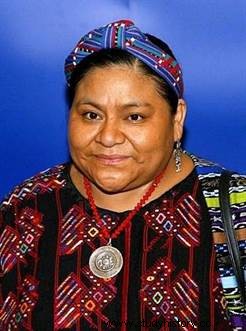 It is important to note that in 1992, Rigoberta Menchu , a descendant of the "quiché" Mayans from Guatemala, was awarded the Nobel Peace Prize. Rigoberta Menchu, whose family members were decimated by the civil war, got involved early for the recognition of her rights. At 20, she joined the CUC (Comité de l’Union Paysane), a protest organization and continued to work for social justice and respect for indigenous peoples.
It is important to note that in 1992, Rigoberta Menchu , a descendant of the "quiché" Mayans from Guatemala, was awarded the Nobel Peace Prize. Rigoberta Menchu, whose family members were decimated by the civil war, got involved early for the recognition of her rights. At 20, she joined the CUC (Comité de l’Union Paysane), a protest organization and continued to work for social justice and respect for indigenous peoples.
Bibliography
- GENDROP Paul, Les Mayas, puf, 2011.
- From Arthur Andrew Demarest, The Mayas:Rise and Fall of a Civilization, Tallandier, 2007.
- By Antonio Aimi, Raphael Tunesi, The Mayas and the Aztecs, Hazan, 2009.
- GRUBE Nikolai (sdd), Mayas, The Sacred Gods of the Rainforest, HF Ullmann Editions, 2012.
- TAUBE Karl, Aztec and Mayan Myths, Editions du Seuil, 1995.
